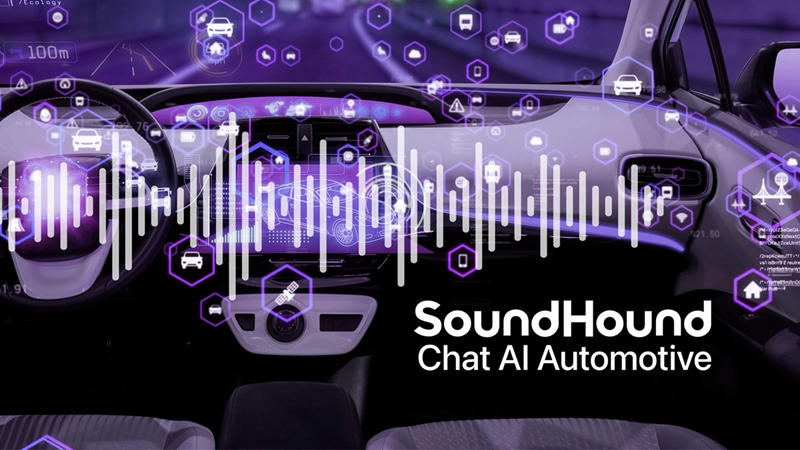SoundHound AI Introduces Generative AI Voice Assistant to Alfa Romeo and Citroën Vehicles in Europe
SoundHound Inc., the leading innovator in voice-enabled AI and conversational intelligence technologies, is set to revolutionize the driving experience in Europe by introducing its Generative AI Voice Assistant to Alfa Romeo and Citroën vehicles. This remarkable development in automobile technology signifies a new era of in-car experiences, offering drivers and passengers a more sophisticated, personalized, and interactive journey. The AI-powered assistant provides users with an intuitive way of controlling various vehicle functions such as navigation, entertainment, and climate settings through voice commands, hence reducing distractions while driving.
The integration of SoundHound’s AI Voice Assistant into Alfa Romeo and Citroën vehicles aims to redefine the way people interact with their cars. This technology uses Natural Language Understanding (NLU), which enables it to understand and process complex and conversational voice commands. It can understand queries in various forms, contexts, and languages, making it a versatile tool for drivers of different nationalities.
SoundHound’s partnership with Alfa Romeo and Citroën marks a significant step forward in the automobile industry’s digital transformation. It’s not just about adding a new feature to the car; it’s about enhancing the overall driving experience and making it safer, more comfortable, and more enjoyable for the users. With the AI Voice Assistant, drivers can access real-time traffic updates, weather forecasts, and navigation instructions by simply using their voice. The technology also allows for seamless connectivity with smartphones, enabling drivers to make calls, send messages, and even manage their schedule while keeping their hands on the wheel and eyes on the road.
In addition to its practical benefits, the Generative AI Voice Assistant also adds a layer of luxury to Alfa Romeo and Citroën vehicles. With its ability to learn and adapt to the driver’s preferences over time, the AI Voice Assistant can provide a highly personalized driving experience. For instance, it can remember the driver’s favorite music, preferred temperature settings, and frequently visited destinations, and make recommendations accordingly.
Moreover, the introduction of the AI Voice Assistant is a testament to SoundHound’s commitment to integrating AI technology into everyday life. It signifies the company’s forward-thinking approach and its dedication to improving user experiences through innovative technology. By partnering with Alfa Romeo and Citroën, SoundHound has not only brought its AI technology to the European market but has also set a new standard for in-car user experiences.
In conclusion, the integration of SoundHound’s Generative AI Voice Assistant into Alfa Romeo and Citroën vehicles promises to transform the way we interact with our cars. By enabling voice control of various vehicle functions, it offers drivers a safer and more convenient way of managing their journey. Moreover, with its ability to provide personalized experiences, the AI Voice Assistant adds a touch of luxury to the driving experience. This development marks a significant milestone in the digital transformation of the automobile industry and highlights the potential of AI technology in enhancing our everyday lives.

Overview of SoundHound AI’s Latest Integration
SoundHound AI’s latest integration represents a significant leap forward in voice-enabled artificial intelligence (AI) technology. The company, known for its innovative approaches in sound recognition and search technologies, has recently integrated its AI technology into various interfaces and devices, thereby broadening its reach and enhancing user experience. This move demonstrates SoundHound AI’s commitment to staying ahead of the technology curve and maintaining a competitive edge in the rapidly evolving AI industry.
One of the latest integrations involves SoundHound AI’s voice AI platform, Houndify, being incorporated into the Mercedes Benz User Experience (MBUX) system. This integration enables drivers to interact with their vehicles using voice commands, thus ensuring a safer and more convenient driving experience. It reflects how SoundHound AI is expanding its footprint in the automotive industry by providing AI solutions that are not only innovative, but also practical and user-friendly.
Another notable integration is with Snapchat, a popular social media platform. Snapchat users can now identify and share music through SoundHound’s music recognition technology. This collaboration has made it easier for users to share their favorite music, thus enhancing their social media experience. It also showcases how SoundHound AI’s technology can be effectively utilized in diverse industries, ranging from automotive to social media.
SoundHound AI’s latest integration efforts represent a strategic move to extend its influence beyond traditional boundaries and to establish a strong presence in new markets. By integrating its technology into various interfaces and devices, SoundHound AI is not only improving user experience but also creating new opportunities for growth and expansion in the AI industry. With these developments, SoundHound AI continues to solidify its position as a leader in voice-enabled AI technology.
How Generative AI Enhances In-Car Voice Assistants
With the rapid evolution of technology, Generative AI has significantly transformed the automotive industry, particularly enhancing in-car voice assistants. Generative AI, through its ability to generate human-like text, has significantly improved the user interaction with in-car voice assistants. These enhanced voice assistants can now accurately interpret natural language, understand context, and provide relevant, detailed responses. This results in a more personalized and intuitive user experience, which ensures safer driving as drivers can maintain their focus on the road.
Generative AI has transformed the voice assistant from a simplistic command-based system to an interactive, conversational interface. It enables the assistant to generate dynamic responses, even to unpredictable or complex queries, by understanding the user’s intent. This technology also allows the voice assistant to learn from previous interactions, which further enhances its ability to engage in meaningful and efficient conversations with the driver.
In addition, Generative AI-powered voice assistants can perform a wider range of tasks more effectively. They can control various in-car systems such as navigation, entertainment, and climate control, make recommendations based on preferences learned over time, or even carry out tasks like making restaurant reservations or setting reminders. They can also provide real-time updates about traffic conditions, weather information, or vehicle health status, among other things, by synthesizing information from various sources.
Furthermore, with advancements in AI, the in-car voice assistant can now understand and respond to multiple languages, accents, and speech patterns, making it accessible to a diverse range of users worldwide. It also ensures privacy as voice data can be processed locally within the vehicle, reducing the reliance on cloud-based processing.
In summary, Generative AI has immensely enriched in-car voice assistants, making them more interactive, efficient, and user-friendly. It has not only transformed the driving experience by allowing hands-free control of various in-car features but also enhanced safety by enabling drivers to keep their eyes on the road and hands on the wheel.

Impact on Alfa Romeo and Citroën Drivers
The impact on Alfa Romeo and Citroën drivers has been significant in recent years, primarily due to advancements in technology and changes in consumer behaviors. On the one hand, both brands have adapted to these changes by introducing their electric and hybrid models, which have been met with favorable responses from environmentally conscious drivers. On the other hand, the increasing demand for connectivity and smart features in vehicles has put pressure on these brands to innovate and adapt.
For Alfa Romeo, a brand that is closely associated with luxury and performance, this has meant integrating cutting-edge technology without compromising the driving experience that their customers have come to expect. This is evidenced in models like the Giulia and Stelvio, which are equipped with advanced driver assistance systems, infotainment options, and other features that make driving safer, more convenient, and more enjoyable.
Meanwhile, Citroën, a brand renowned for its comfort and practicality, has been focusing on enhancing its vehicles’ interior space and ergonomics. They have introduced models like the C4 Cactus and the new C5 Aircross SUV, which are designed to offer the utmost comfort, space and modularity, making them perfect for families and long drives.
However, these improvements and innovations do not come without challenges. The transition to electric and hybrid vehicles, for instance, requires substantial investment in research and development, as well as modifications in manufacturing processes. Furthermore, the integration of smart features necessitates a deeper understanding of the latest technologies and customer needs.
Despite these challenges, the impact on Alfa Romeo and Citroën drivers has been largely positive. They now have access to a wider range of options that cater to different lifestyles and preferences. At the same time, these brands have been able to maintain their unique identities and values, ensuring that their customers continue to enjoy the distinct driving experiences that they are known for.
Technology Behind the New Voice Assistant
The technology behind the new voice assistant is a fusion of artificial intelligence (AI) and machine learning algorithms, which together facilitate the understanding of human speech patterns and responses. Key elements of this technology include Automatic Speech Recognition (ASR), Natural Language Understanding (NLU), and Text-to-Speech (TTS). ASR is the first step in the process, interpreting spoken words into written text. NLU then steps in, deciphering the context and intent of the text, enabling the voice assistant to comprehend the user’s request accurately.
Then, TTS technology converts the assistant’s response from written text back into spoken words, creating a seamless conversation flow. Furthermore, the integration of machine learning allows the assistant to evolve over time, improving its understanding and response accuracy with each interaction. This growth ability is facilitated by a procedure called deep learning, a subset of machine learning, which uses artificial neural networks to mimic the human brain’s functioning. With each user interaction, these networks adapt and refine their understanding of language and context, enhancing the assistant’s communication skills.
The advanced voice assistant also incorporates user data to provide personalized assistance, such as preferred news sources or music playlists, ensuring a tailored user experience. Despite the sophisticated technology, the goal is to create a user-friendly and intuitive interface that can interact naturally with users, fostering a sense of connection and reducing the need for typed commands. Ultimately, the technology behind the new voice assistants is continually advancing, with the potential to revolutionize the way we interact with our devices.

Expansion Plans and Future Developments
Expansion plans and future developments are integral components of any successful business strategy. These involve broadening the scope of business operations, either by introducing new products or services, reaching out to new markets, or enhancing production capability. The main objective of these plans is to ensure sustainable growth and profitability in the ever-evolving business landscape. It is therefore essential for businesses to have a well-defined, comprehensive, and flexible expansion strategy in place.
Furthermore, future developments refer to innovative technologies, systems, and procedures that a business plans to adopt or implement to enhance its competitive edge. These may include automation, digitization, artificial intelligence, or any other cutting-edge technology that can increase efficiency, productivity, or customer satisfaction. Future developments also involve anticipating changes in the market environment and consumer behavior, and adapting the business operations accordingly.
However, expansion plans and future developments are not without their challenges. They require significant investment in terms of resources, time, and capital. They may also necessitate changes in the organizational structure, business processes, and corporate culture. Therefore, it is imperative for businesses to conduct a thorough analysis of the potential risks and benefits before embarking on any expansion plan or future development.
In conclusion, expansion plans and future developments are essential for businesses seeking to stay ahead of the competition and achieve long-term success. They require careful planning, diligent execution, and constant monitoring to ensure they align with the company’s overall strategic objectives and market realities. Therefore, businesses must invest in building their capabilities and resources to effectively execute these plans and adapt to future developments.
